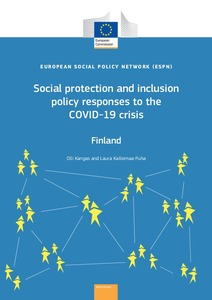Social protection and inclusion policy responses to the COVID-19 crisis
Kangas Olavi; Kalliomaa-Puha Laura
https://urn.fi/URN:NBN:fi-fe202301051523
Tiivistelmä
Due to the universal nature of social protection schemes in Finland, young people’s access to social protection is generally good. Most schemes apply to all residents, regardless of their age or citizenship. In principle, Finnish social security comprises three parts. The first component guarantees minimum-income security for all residents. It includes “basic level” social benefits that are paid either on a flat-rate basis or after income-/means-testing. The second component consists of income-related social insurance for those in employment. In most income-transfer schemes, age is not a criterion; rather, criteria are based on the need for care or the need for income support. The third component of the system includes municipal social and healthcare services that universally cover all residents, from cradle to grave. Obstacles and problems in access to benefits may arise in very specific life situations among young people. Being under 18 means that one’s parents are obliged to provide for one’s livelihood. Therefore, many benefits do not provide for younger minors. Up to the age of 16 (since 1 August 2021 up to 18), youngsters participate in compulsory education; hence, those aged 16-25 are mainly involved in education. Their employment periods are therefore sporadic, which means that their opportunities to fulfil the contributory history required for unemployment benefits are limited. Furthermore, in order to get income-related unemployment benefits, claimants must be members of an unemployment fund. Fund membership is voluntary. Young people have a lower membership rate than older ones. In principle, it is possible to join the fund at the age of 17. However, due to ignorance and sporadic employment spells, young people have problems becoming members and fulfilling the employment criteria (26 weeks of work, minimum of 18 hours per week, in the previous 28 months) for benefit recipiency. There are also incentives to encourage young people to participate in education. Social assistance can be reduced if a claimant who is under 25 has no occupational training or is not participating in employment-promoting services. The Finnish minimum-benefits system guarantees income transfers to those who are not employed and do not have income from employment. The minimum sickness allowance (payable to everyone aged 16-67) is a good example. For instance, students, stay-at-home parents, and other groups who have no income will get income support in the event of sickness. There are no age-based exclusions. In contributory schemes, eligibility for benefits (or pension accumulation) begins at the age of 17. Universal child allowance is payable up to that age. The obligatory school age extends to 18, which means that the labour market participation of people younger than that remains low. The universal study grant, which is free, compensates for their low income from employment. The social security system’s universality and comprehensiveness reflect good practice. Furthermore, municipalities are obliged to form a co-ordination network offering counselling and planning services to the young. The network must include representatives of the local education, social and healthcare, youth work, and employment and policy authorities. Unemployment and working under precarious conditions make young people vulnerable to health problems, especially mental health problems. The novel coronavirus (COVID-19) pandemic has accentuated problems in healthcare in general, and in mental healthcare and therapeutic rehabilitation in particular. Lengthy waiting lists and queues jeopardise access to essential services. Investing in effective services, implementing early intervention, and fostering preventive environments are all necessary to keep vulnerable young people in educational institutions and help them adapt to working life.
Kokoelmat
- Rinnakkaistallenteet [27094]
